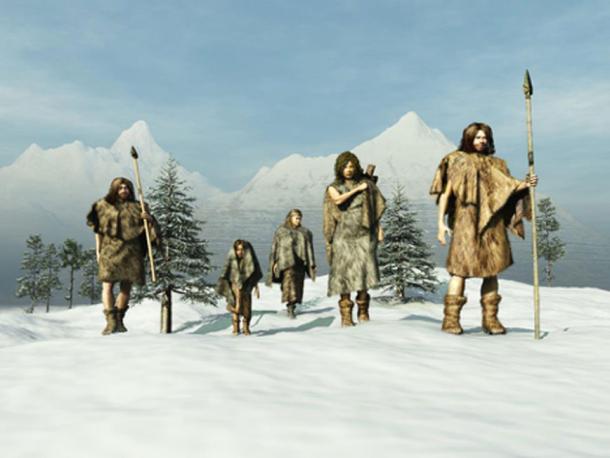
DNA Study Suggests Early Neanderthals Had Europe As Their Homebase
The Neanderthal story began around 430,000 years ago and (mostly) ended with their demise about 40,000 years ago. They left their mark in Europe and central Asia and on the genes of many people today, and over the years scientists have accumulated a good deal of knowledge about Neanderthals. We have quite a lot of information about their diet, living spaces, interbreeding with Homo sapiens and Denisovans, and burial practices, for example.
However details on the interaction and migration of early Neanderthal populations is still limited. The lack of ancient DNA dating back more than 100,000 years is a major hinderance in piecing together this part of the puzzle. But a team from the Max Planck Institute for Evolutionary Anthropology in Leipzig, Germany is making headway in this area. Their research suggests that Europe was the main homeland for many Neanderthals but their populations repeatedly moved to the east and back again.

Neanderthal. (procy_ab / Adobe Stock)
Lead researcher Stéphane Peyrégne told New Scientist:
“It’s the first time we can look at Neanderthals in Europe across a long period of time. It’s very exciting because we don’t know about the early history of Neanderthals. We can start asking questions about the relationships of the different Neanderthals that occupied Europe.”
- Research Confirms that Neanderthal DNA Makes Up About 20% of the Modern Human Genome
- Spectacular Science! Lab-Grown Mini Neanderthal Brains Could Explain What Makes Humans Different
- All About Neanderthals – The Surprising Facts
Where did the Researchers Get the Neanderthal DNA?
Neanderthal DNA is not very easy to acquire due to degradation over time and the contamination of modern human microbes into the prehistoric bones.
But their paper, published in Science Advances, explains that the Max Planck team were able to extract nuclear genomic sequences from the remains of two 120,000-year-old Neanderthals, one from the thigh bone of a Neanderthal found in Hohlenstein-Stadel Cave in Germany and the other from an upper jawbone from the Scladina Cave in Belgium.

DNA was taken from this Neanderthal jawbone found in Scladina Cave in Belgium. (J. Eloy, AWEM, Archéologie andennaise)
Cosmos writes that the nuclear DNA was obtained through powder that came from clean bones that had been drilled into with a dental drill. However, “after decades of handling, the samples were peppered with genetic sequences from modern humans. So the team narrowed their focus on sequences with the clear signs of degradation that occurs with the ravages of time, and then compared these to known Neanderthal sequences to build a family tree.”
The Neanderthal DNA from Germany and Belgium was then compared with the genetic information of two Neanderthals that lived in Denisova cave in Siberia, one who had lived 90,000 years ago and the other 120,000 years ago – the same time frame as the older European samples. Later European Neanderthal DNA, from the end of the population roughly 40,000 years ago, was also examined.

This is the femur of a male Neandertal from Hohlenstein-Stadel Cave, Germany. (© Oleg Kuchar, Museum Ulm)
What Stories Does the Ancient Neanderthal DNA Tell?
The results of the study show two main things. Firstly that the Neanderthal remains found in Belgium and Germany were more closely related to the later European Neanderthals than the population living in the Siberian region 120,000 years ago. As the scientists write in their paper:
“both Neandertals are genetically closer to later Neandertals from Europe than to a roughly contemporaneous individual from Siberia. That the Hohlenstein-Stadel and Scladina individuals lived around the time of their most recent common ancestor with later Neandertals suggests that all later Neandertals trace at least part of their ancestry back to these early European Neandertals.”
- Tooth Study Has Modern Humans Splitting From Neanderthals 400,000 Years Earlier Than Thought
- New Studies Clash with Previous Analyses On the Life and Fate of Neanderthals
- New Evidence Questions the Time and Place of Neanderthal Extinction

Cave Hohlenstein-Stadel, Lonetal valley, southern Germany. (Thilo Parg/CC BY SA 3.0)
The second discovery they made was that the 90,000-year-old genes of the Neanderthal in Denisova cave were also more closely related to the Hohlenstein-Stadel and Scladina Neanderthals than the population that had used the same cave in Siberia 30,000 years before them. This suggests that the Neanderthals who lived in what is now Europe returned to the area of Siberia at some point in time and their genes replaced the earlier Siberian Neanderthals.
Katerina Harvati of the University of Tübingen, Germany, who didn’t take part in the study, summed up the results, “The continuity of the Neanderthal lineage in Europe suggests that Europe was the core area of Neanderthals, from which they repeatedly dispersed to the east, possibly in reaction to climatic cycles.”

Neanderthals in the Ice Age. (anibal /Adobe Stock)
Top Image: Representation of a Neanderthal. A new study of Neanderthal DNA tells the story of their migrations between Europe and Siberia. Source: procy_ab /Adobe Stock
















